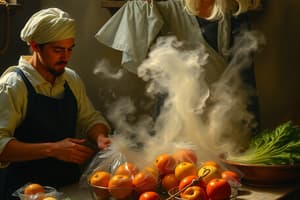Podcast
Questions and Answers
What is the primary effect of freezing food at low temperatures?
What is the primary effect of freezing food at low temperatures?
- It significantly increases the number of viable microorganisms.
- It sterilizes the food completely.
- It reduces the number of viable microorganisms but does not sterilize. (correct)
- It causes food to spoil faster.
Which type of drying method can effectively maintain the color and vitamin content of food?
Which type of drying method can effectively maintain the color and vitamin content of food?
- Treatment with SO2 before drying (correct)
- Freeze drying
- Sun drying
- Spray drying
What water activity level (Aw) is considered most unlikely for spoilage to occur in dried foods over a period of up to 2 years?
What water activity level (Aw) is considered most unlikely for spoilage to occur in dried foods over a period of up to 2 years?
- Aw of 0.65 (correct)
- Aw of 0.80
- Aw of 0.70
- Aw of 0.75
How does fast freezing differ from slow freezing in terms of ice crystal formation and food quality?
How does fast freezing differ from slow freezing in terms of ice crystal formation and food quality?
Which treatment before drying significantly reduces the number of microorganisms by using heat?
Which treatment before drying significantly reduces the number of microorganisms by using heat?
What is the main purpose of using supercritical carbon dioxide (SCCO2) in food processing?
What is the main purpose of using supercritical carbon dioxide (SCCO2) in food processing?
Which bioactive compounds can be extracted using supercritical carbon dioxide?
Which bioactive compounds can be extracted using supercritical carbon dioxide?
What is a significant limitation of pulsed light technology in food processing?
What is a significant limitation of pulsed light technology in food processing?
At what pressure range is high hydrostatic pressure processing (HPP) typically conducted?
At what pressure range is high hydrostatic pressure processing (HPP) typically conducted?
How do flexible containers facilitate the high hydrostatic pressure processing of foods?
How do flexible containers facilitate the high hydrostatic pressure processing of foods?
What is the primary mechanism of microbial inactivation during high hydrostatic pressure processing?
What is the primary mechanism of microbial inactivation during high hydrostatic pressure processing?
What kind of light does pulsed light technology utilize for irradiating surfaces?
What kind of light does pulsed light technology utilize for irradiating surfaces?
Which of the following is a reason for pulsed light technology not being widely adopted in food processing?
Which of the following is a reason for pulsed light technology not being widely adopted in food processing?
What type of medium is used in the high-pressure chamber during HPP?
What type of medium is used in the high-pressure chamber during HPP?
What is the primary principle behind Pulsed Electric Field (PEF) technology?
What is the primary principle behind Pulsed Electric Field (PEF) technology?
Which of the following food items can benefit from PEF technology?
Which of the following food items can benefit from PEF technology?
What effect does PEF have on enzymes in the food industry?
What effect does PEF have on enzymes in the food industry?
What is the main advantage of combining PEF with mild heating?
What is the main advantage of combining PEF with mild heating?
In the context of UV light technology, what is its primary application?
In the context of UV light technology, what is its primary application?
How does UV light primarily exert its germicidal properties?
How does UV light primarily exert its germicidal properties?
What potential effect can pulsed UV light have on food products?
What potential effect can pulsed UV light have on food products?
What frequency defines ultrasound, which is beyond human hearing?
What frequency defines ultrasound, which is beyond human hearing?
Which method is NOT used to prevent microbial decomposition in food preservation?
Which method is NOT used to prevent microbial decomposition in food preservation?
Which of the following is a method to extract active ingredients from food using ultrasound?
Which of the following is a method to extract active ingredients from food using ultrasound?
What is one of the mechanisms by which ultrasound affects food processing?
What is one of the mechanisms by which ultrasound affects food processing?
Which principle does NOT contribute to food preservation?
Which principle does NOT contribute to food preservation?
What is the purpose of using asepsis in food preparation?
What is the purpose of using asepsis in food preparation?
Which method of food preservation does NOT involve temperature control?
Which method of food preservation does NOT involve temperature control?
What type of reaction is targeted when preventing oxidation in food preservation?
What type of reaction is targeted when preventing oxidation in food preservation?
Which is an effective way of preventing damage from insects in food preservation?
Which is an effective way of preventing damage from insects in food preservation?
What is a common property of the natural protection found in food?
What is a common property of the natural protection found in food?
What is the primary objective of heating foods during preparation?
What is the primary objective of heating foods during preparation?
Which method involves heating foods above 100°C to destroy spoilage and pathogenic microorganisms?
Which method involves heating foods above 100°C to destroy spoilage and pathogenic microorganisms?
What is a characteristic of chilling temperatures in food preservation?
What is a characteristic of chilling temperatures in food preservation?
What is the risk involved in the canning process?
What is the risk involved in the canning process?
What happens to thermophilic spores if commercially sterile foods are not stored properly?
What happens to thermophilic spores if commercially sterile foods are not stored properly?
Which of the following is a method employed at about 100°C to preserve acid foods?
Which of the following is a method employed at about 100°C to preserve acid foods?
What is the effect of low temperatures on chemical reactions in food?
What is the effect of low temperatures on chemical reactions in food?
Which microorganisms can grow at chilling temperatures?
Which microorganisms can grow at chilling temperatures?
What is an effect of heating food at ultra-high temperatures?
What is an effect of heating food at ultra-high temperatures?
What is a common part of the canning process?
What is a common part of the canning process?
Flashcards
Pulsed Electric Field (PEF)
Pulsed Electric Field (PEF)
A non-thermal food preservation technique using high voltage electric pulses to inactivate microbes and enzymes, and enhance extraction of compounds.
PEF's Effect on Food
PEF's Effect on Food
PEF improves food safety, extends shelf life, enhances compound extraction (like oils, polyphenols), and speeds up drying.
PEF & Mild Heating
PEF & Mild Heating
Combining PEF with gentle heating boosts microbial inactivation and extends food's shelf life.
Pulsed UV Light
Pulsed UV Light
Signup and view all the flashcards
UV Light & Food Safety
UV Light & Food Safety
Signup and view all the flashcards
UV Light & Food Properties
UV Light & Food Properties
Signup and view all the flashcards
UV Light Mechanism
UV Light Mechanism
Signup and view all the flashcards
SCCO2 Processing
SCCO2 Processing
Signup and view all the flashcards
SCCO2 Advantages
SCCO2 Advantages
Signup and view all the flashcards
Pulsed Light Application
Pulsed Light Application
Signup and view all the flashcards
Pulsed Light Limitations
Pulsed Light Limitations
Signup and view all the flashcards
High Hydrostatic Pressure Processing (HPP)
High Hydrostatic Pressure Processing (HPP)
Signup and view all the flashcards
HPP Mechanism
HPP Mechanism
Signup and view all the flashcards
HPP Process
HPP Process
Signup and view all the flashcards
HPP Factors
HPP Factors
Signup and view all the flashcards
Ultrasound in Food Processing
Ultrasound in Food Processing
Signup and view all the flashcards
Ultrasound & Cell Disruption
Ultrasound & Cell Disruption
Signup and view all the flashcards
Food Preservation Principles
Food Preservation Principles
Signup and view all the flashcards
Asepsis in Food Preservation
Asepsis in Food Preservation
Signup and view all the flashcards
Methods of Food Preservation
Methods of Food Preservation
Signup and view all the flashcards
Natural Protection in Food
Natural Protection in Food
Signup and view all the flashcards
Packaging for Food Preservation
Packaging for Food Preservation
Signup and view all the flashcards
Sanitary Food Handling
Sanitary Food Handling
Signup and view all the flashcards
Anaerobic Conditions for Food
Anaerobic Conditions for Food
Signup and view all the flashcards
High Temperature Preservation
High Temperature Preservation
Signup and view all the flashcards
Freezing and Food Safety
Freezing and Food Safety
Signup and view all the flashcards
Fast Freezing Benefits
Fast Freezing Benefits
Signup and view all the flashcards
Drying and Food Preservation
Drying and Food Preservation
Signup and view all the flashcards
Types of Drying Methods
Types of Drying Methods
Signup and view all the flashcards
Drying Treatment Beforehand
Drying Treatment Beforehand
Signup and view all the flashcards
Spore-Killing Heat
Spore-Killing Heat
Signup and view all the flashcards
Steam Under Pressure
Steam Under Pressure
Signup and view all the flashcards
Ultra-High Temperature (UHT)
Ultra-High Temperature (UHT)
Signup and view all the flashcards
Objective of Heating Food
Objective of Heating Food
Signup and view all the flashcards
Canning Process
Canning Process
Signup and view all the flashcards
Underprocessing Risk
Underprocessing Risk
Signup and view all the flashcards
Chilling Temperature
Chilling Temperature
Signup and view all the flashcards
Psychrotrophs
Psychrotrophs
Signup and view all the flashcards
Study Notes
Non-food Processing and Food Preservation
- The lecture covers food preservation methods, including thermal and non-thermal processes.
- Food preservation techniques aim at preventing microbial decomposition and self-decomposition of food, as well as damage from insects, animals and other factors.
- Methods for achieving microbial decomposition include asepsis, removal of microorganisms, maintenance of anaerobic conditions, use of high and low temperatures, drying, smoking, use of chemical preservatives, irradiation, and mechanical destruction of microorganisms.
Types of Thermal Heat Processing
- Heat processing methods use steam or water (boiling, blanching, pasteurization, heat sterilization, evaporation, and distillation), hot air (dehydration, baking, roasting), hot oils (frying).
- Heat processing can use direct and radiated energy (infrared, dielectric, ohmic).
- Processing by removal of heat includes chilling, freezing, and freeze drying.
Non-thermal Processing: An Introduction
- Traditional food technologies, like pasteurization and sterilization, may destroy essential nutrients (vitamins, polyphenols) to maintain food safety.
- Non-thermal methods aim to prolong shelf life and preserve quality without affecting these essential nutrients.
- Non-thermal methods have increased production rates and profit margins for the food industry.
Non-thermal Processing Methods
- Pulsed electrical field (PEF)
- Pulsed ultraviolet method
- Irradiation method
- Cold plasma
- Supercritical carbon dioxide
- Pulsed light
- High hydrostatic pressure processing
- Radio frequency and microwave
- Ultrasound
Pulsed Electrical Field (PEF)
- PEF uses high-voltage electric pulses to inactivate enzymes and extend shelf life.
- Applications include vegetable and fruit juices, milk, and liquid eggs.
- PEF enhances extraction of intracellular compounds (plant oil, polyphenols, pigments).
- It improves drying rates for foods like potatoes and meat, and accelerates wine ageing reactions.
- Combined with mild heating, enhances microbial inactivation.
- Destroy pathogens by destroying cell membranes, and oxidation of macromolecules.
Ultraviolet (UV)
- Pulsed UV light inactivates surface microorganisms.
- Used for disinfecting water supplies and food contact surfaces.
- Effective against Salmonella on unpackaged and vacuum-packaged foods.
- Extends shelf life without major alteration to food quality in foods like juices and milk
Irradiation
- Authorized ionizing radiation (gamma rays, X-rays, accelerated electrons) applied to food.
- Mechanism involves direct/indirect damage to microbial nucleic acids (DNA).
- Important application for decontamination of spices, herbs, and condiments.
- Useful for ready-to-eat meat, and fresh mushrooms, extending their shelf life.
Cold Plasma
- Ionization of gas generates reactive species that kill microorganisms.
- Used to sterilize cherry tomatoes, strawberries, almonds, and food packaging materials.
- Relatively complex equipment needed but is effective on fruits, vegetables and meats.
Supercritical Carbon Dioxide (SCCO2)
- Supercritical fluid state of carbon dioxide at or above its critical temperature and pressure.
- Effective for inactivation of microorganisms and enzymes in fruit and vegetable products (juices, purees, smoothies).
- Green Technology for extracting bioactive compounds (carotenoids, flavonoids, phenols.) from fruits and vegetables.
- Doesn't use organic solvents, which is eco-friendly.
Pulsed Light
- Surface irradiation, not penetration.
- Short intense light pulses in UV to NIR range from Xenon lamps.
- Effective for surface microorganism control.
- Food safety and extended shelf life.
High Hydrostatic Pressure Processing (HPP)
- High pressure treatment (300-600 MPa) in flexible containers submerged in pressurized water.
- Achieves microbial inactivation.
- Irreversible destruction of cellular structures (cell membranes, cell walls)
- Useful in seafood processing, cooked meat and poultry products, ready-to-eat products
- Preserves desirable characteristics like appearance, texture and nutrition.
Radio Frequency and Microwave
- Electromagnetic waves to generate heat in materials.
- Dipolar interaction: Water molecules rotate in the alternating electric field, producing heat.
- Ionic interaction: Ions collide with other molecules, also generating heat.
- Used for pasteurization and sterilization due to the rapid heating that occurs.
Ultrasound
- Mechanical waves above the human hearing threshold.
- Used to increase mass transfer, degassing, defoaming, filtration, emulsification, protein hydrolysis in food preservation and extraction.
- Creates intracellular cavitation, destroying cell membranes which inhibits microbial growth.
- Used for preserving fruits, vegetables and their juices.
Principles of Food Preservation
- Prevention of microbial decomposition: Keeping out/removing microorganisms (asepsis, filtration), or hindering/killing their growth (drying, anaerobic conditions, lowering the temperature, heat or radiation).
- Prevention of self-decomposition: Preventing/inactivating food enzymes, and mitigating chemical reactions.
- Prevention of damage: Protecting against insects, animals, mechanical damage.
Methods of Food Preservation
- Asepsis
- Removal of microorganisms
- Maintenance of anaerobic conditions
- Use of high and low temperatures, Drying, Smoking
- Use of chemical preservatives
- Irradiation
- Mechanical destruction of microorganisms, Combinations of methods
Chemical Preservatives
- Substances to prevent food deterioration.
- Inhibit microbial activity by interfering with cell membranes, enzymes, or genetic mechanisms.
- Used as antioxidants, acidity neutralizers, stabilizers, firming agents, coatings, and to prevent water loss.
- Common types include propionates, benzoates, sorbates, acetates (e.g., dehydroacetic acid, acetic acid), nitrites/nitrates, sulfur dioxide/sulfites, and ethylene propylene oxide (used for fumigation).
Other Preservative Methods
- Filtration is used to remove microorganisms like in juices, soft drinks, water.
- Radiation (gamma and X-rays) sterilises food, often a cheaper and potentially more effective method than thermal treatments, but may have limitations related to public perception.
- Antibiotics are used for extending the storage life of raw food.
Studying That Suits You
Use AI to generate personalized quizzes and flashcards to suit your learning preferences.




